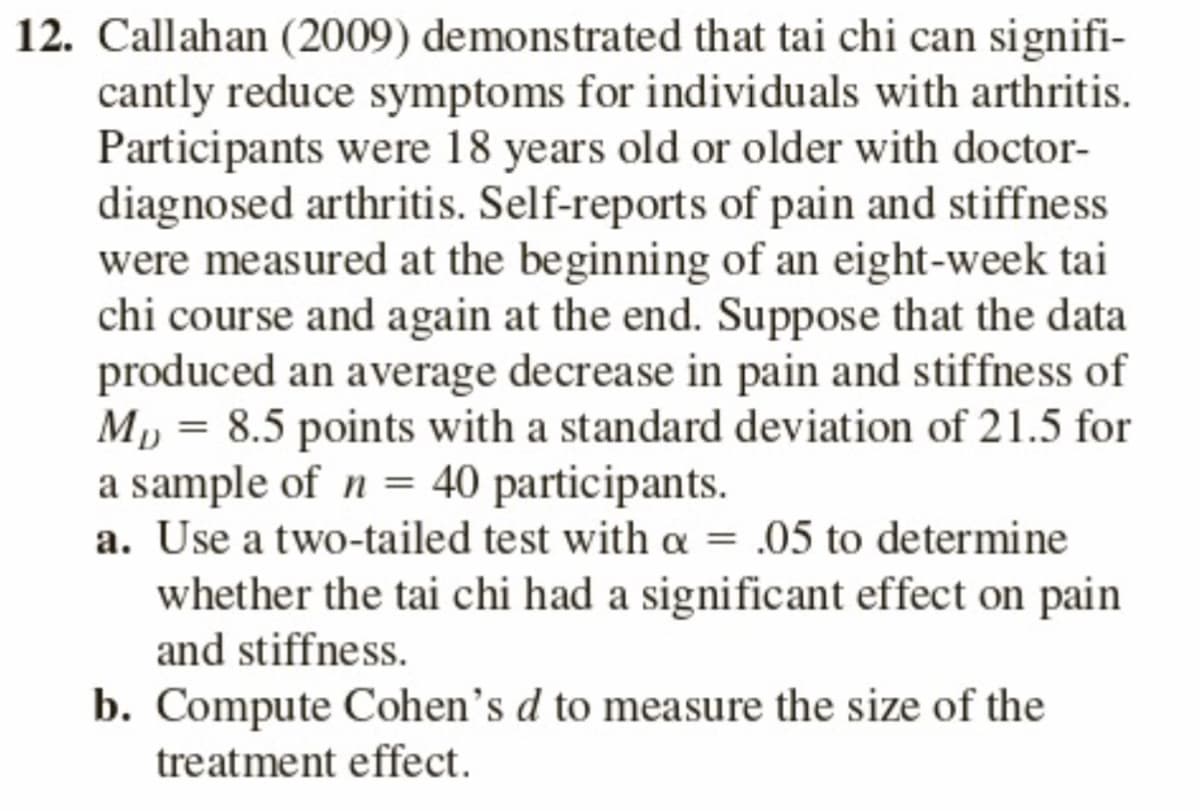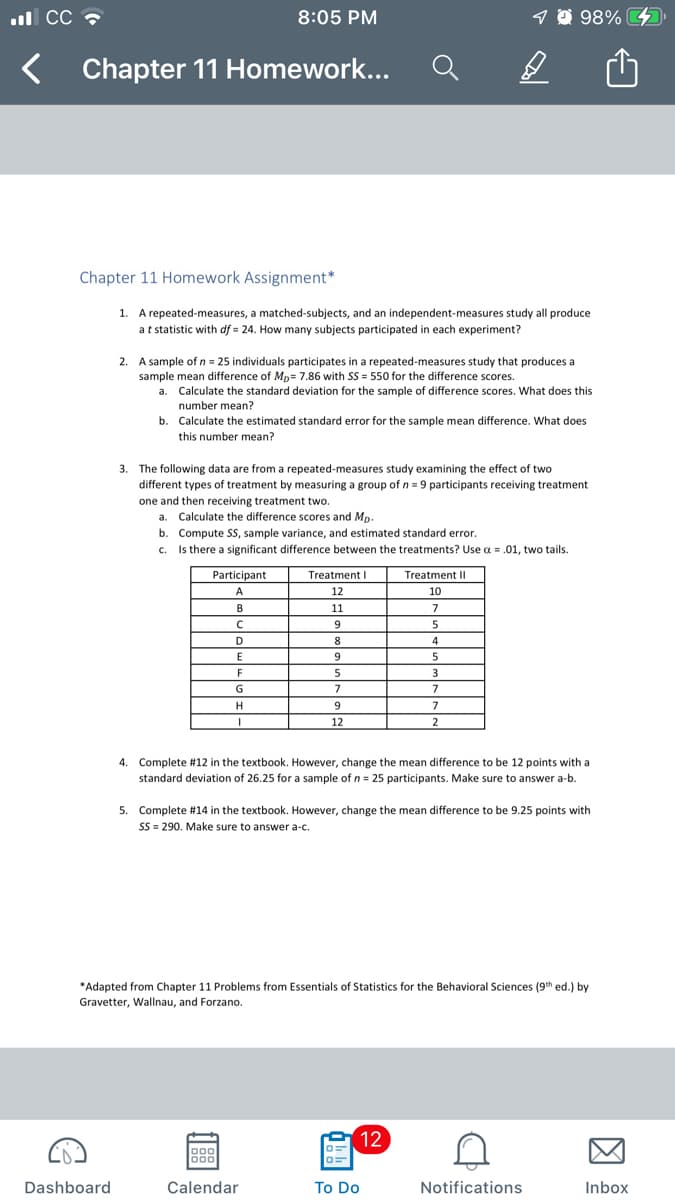12. Callahan (2009) demonstrated that tai chi can signifi- cantly reduce symptoms for individuals with arthritis. Participants were 18 years old or older with doctor- diagnosed arthritis. Self-reports of pain and stiffness were measured at the beginning of an eight-week tai chi course and again at the end. Suppose that the data produced an average decrease in pain and stiffness of Mp = 8.5 points with a standard deviation of 21.5 for a sample of n = 40 participants. a. Use a two-tailed test with a = .05 to determine whether the tai chi had a significant effect on pain and stiffness. b. Compute Cohen's d to measure the size of the treatment effect.
12. Callahan (2009) demonstrated that tai chi can signifi- cantly reduce symptoms for individuals with arthritis. Participants were 18 years old or older with doctor- diagnosed arthritis. Self-reports of pain and stiffness were measured at the beginning of an eight-week tai chi course and again at the end. Suppose that the data produced an average decrease in pain and stiffness of Mp = 8.5 points with a standard deviation of 21.5 for a sample of n = 40 participants. a. Use a two-tailed test with a = .05 to determine whether the tai chi had a significant effect on pain and stiffness. b. Compute Cohen's d to measure the size of the treatment effect.
Holt Mcdougal Larson Pre-algebra: Student Edition 2012
1st Edition
ISBN:9780547587776
Author:HOLT MCDOUGAL
Publisher:HOLT MCDOUGAL
Chapter11: Data Analysis And Probability
Section: Chapter Questions
Problem 8CR
Related questions
Question
Help with the questions on my paper and number 4 goes with the textbook questions

Transcribed Image Text:12. Callahan (2009) demonstrated that tai chi can signifi-
cantly reduce symptoms for individuals with arthritis.
Participants were 18 years old or older with doctor-
diagnosed arthritis. Self-reports of pain and stiffness
were measured at the beginning of an eight-week tai
chi course and again at the end. Suppose that the data
produced an average decrease in pain and stiffness of
Mp = 8.5 points with a standard deviation of 21.5 for
a sample of n = 40 participants.
a. Use a two-tailed test with a = .05 to determine
whether the tai chi had a significant effect on pain
and stiffness.
b. Compute Cohen's d to measure the size of the
treatment effect.

Transcribed Image Text:ul CC
8:05 PM
9 @ 98% 4
Chapter 11 Homework...
Chapter 11 Homework Assignment*
1. A repeated-measures, a matched-subjects, and an independent-measures study all produce
at statistic with df = 24. How many subjects participated in each experiment?
2. A sample of n = 25 individuals participates in a repeated-measures study that produces a
sample mean difference of Mp= 7.86 with SS = 550 for the difference scores.
a. Calculate the standard deviation for the sample of difference scores. What does this
number mean?
b. Calculate the estimated standard error for the sample mean difference. What does
this number mean?
3. The following data are from a repeated-measures study examining the effect of two
different types of treatment by measuring a group of n = 9 participants receiving treatment
one and then receiving treatment two.
a. Calculate the difference scores and Mp.
b. Compute Ss, sample variance, and estimated standard error.
Is there a significant difference between the treatments? Use a = .01, two tails.
C.
Participant
Treatment I
Treatment II
A
12
10
B
11
7
9
5
D
8
4
F
3
G
7
7
H
9
7
12
2
4. Complete #12 in the textbook. However, change the mean difference to be 12 points with a
standard deviation of 26.25 for a sample of n = 25 participants. Make sure to answer a-b.
5. Complete #14 in the textbook. However, change the mean difference to be 9.25 points with
SS = 290. Make sure to answer a-c.
*Adapted from Chapter 11 Problems from Essentials of Statistics for the Behavioral Sciences (9h ed.) by
Gravetter, Wallnau, and Forzano.
12
888
000
Dashboard
Calendar
To Do
Notifications
Inbox
Expert Solution
This question has been solved!
Explore an expertly crafted, step-by-step solution for a thorough understanding of key concepts.
This is a popular solution!
Trending now
This is a popular solution!
Step by step
Solved in 2 steps with 2 images

Recommended textbooks for you

Holt Mcdougal Larson Pre-algebra: Student Edition…
Algebra
ISBN:
9780547587776
Author:
HOLT MCDOUGAL
Publisher:
HOLT MCDOUGAL

Holt Mcdougal Larson Pre-algebra: Student Edition…
Algebra
ISBN:
9780547587776
Author:
HOLT MCDOUGAL
Publisher:
HOLT MCDOUGAL